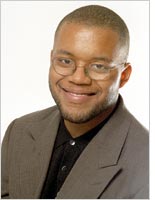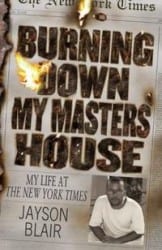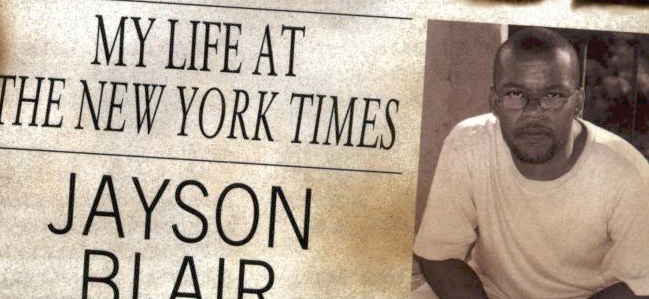Looking Back: 10 Years After Jayson Blair
 Ten years ago today, on May 1, 2003, Jayson Blair turned in his resignation at the New York Times.
Ten years ago today, on May 1, 2003, Jayson Blair turned in his resignation at the New York Times.
What sounds like the end of a long, difficult scandal was actually just the beginning. It was just two days earlier that an editor at the San Antonio Express News told the New York Times, where Jayson Blair worked, that Blair had lifted passages from them for a story about the family of a missing Iraqi War veteran.
Blair’s resignation meant that he was done with the New York Times, but the New York Times was clearly not done with Jayson Blair. A committee of 25 staffers and 3 outside journalists began to investigate Blair’s activities at the paper and quickly began to uncover more and more instances of plagiarism, fabrication and other misdeeds.
The work of that committe led to the publication of a lengthy “Correcting the Record” piece published by The New York Times on May 11, 2003.
The scandal, however, didn’t reach its full peak until the next month when two of the top editors at the New York Times would resign, a move widely seen as an attempt to restore the paper’s credibility.
Ten years later, Jayson Blair is still one of the best-remembered and best-known plagiarists in history, in particular for journalism. Though he may have been somewhat overshadowed recently by the Jonah Lehrer case, which had many similarities to Blair’s case, Blair’s case remains one of the most important and most pivotal plagiarism and ethics scandals in journalism and publishing as a whole.
After a decade, we have a unique opportunity to look back at the scandal, see how it changed journalism, plagiarism and authorship in general.
Recapping the Scandal
 Jayson Blair was brought on at the New York Times as an intern in 1998. He was offered an extended internship the next year but it was postponed so he could complete school, which he never did. Shortly after he was hired as an intermediate reporter and was later brought on as a full-time staff member.
Jayson Blair was brought on at the New York Times as an intern in 1998. He was offered an extended internship the next year but it was postponed so he could complete school, which he never did. Shortly after he was hired as an intermediate reporter and was later brought on as a full-time staff member.
His rise to the top of his industry was astounding to many. At age 27, Blair was the lead reporter on the Beltway Sniper shootings and trial, one of the biggest stories at the time, for the most prominent newspaper in the country.
However, in late April 2003, Macarena Hernandez, a reporter at the San Antonio Express-News and former colleague of Jayson Blair, noticed similarities between a story Blair had written and one she had published two days earlier. She notified her editors, who in turn contacted the New York Times.
Shortly after the paper started investigating Jayson Blair handed in his resignation and checked into a mental health clinic. As the paper began to go through Blair’s history without his help, they discovered dozens of instances of plagiarism, fabrication and deception.
The investigation led to the aforementioned “Correcting the Record” piece but details continued to emerge about Blair’s misdeeds long after, including allegations that he had commited many of the same sins at The Baltimore Sun, which he interned at before The Times, and also had many similar allegations levied at him during his tenure as editor at The Diamondback, the college paper at The University of Maryland, where he attended.
Blair would never work in journalism again but turned up years later as a life coach in Virginia, a job he continues today.
The Impact on Journalism
At the time of the scandal, The New York Times was the premiere newspaper in the country, possibly the world. Such a huge black eye on such an important paper had a major impact not just at The Times, but also on journalism as a whole.
The most immediate and obvious impact was that The Times created the position of public editor. The position is meant to be an editor whose “boss” is the public and addresses the concerns of the public in the newsroom.
The idea was that, if such a position had existed while Blair was engaging in his misdeeds, one of the interviewees Blair had falsely claimed to have spoken to (or someone else from the public) could have easily come forward and stopped him sooner.
The idea of the public editor proved popular, expanding to newspapers across the U.S. However, the role of the public editor had been long filled at other newspapers by the ombudsman, who was supposed to act in a similar capacity, but without the ranking of an editor.
However, Jayson Blair marked two first (or near firsts) in the industry.
For one, Jayson Blair was one of the first “celebrity plagiarists”, meaning someone is famous primarily for their plagiarism. Following his scandal, Blair, who was relatively unknown as a reporter, began to appear on talk shows and even secured a book deal as the story exploded. Though he was a reviled person for his plagiarism, it thrust him into the limelight.
For another, Blair represented one of the first serious cases of plagiarism researched, in part, through crowdsourcing. Though The Times spent nearly two weeks researching Blair’s misdeeds, they still turned to the public for further help and many of the details about Blair’s misdeeds came from those reports.
This would be a pattern that would be much more prevalent during the Jonah Lehrer scandal, where crowdsourcing would take the lead in discovering nearly all of his misdeeds.
In many ways, Blair was a warning of what was to come, especially as plagiarism detection tools become cheaper and easier to use and journalists, facing shrinking newsrooms and increased pressure to publish, are more tempted than ever to take shortcuts.
In short, though Blair changed journalism, his mark was primarily one of caution.
The Impact on Jayson Blair
At the 10-year mark of the scandal, Jayson Blair is remarkably quiet. He’s only granted one interview to the media and, in it, largely declined to talk about his misdeeds.
According to that article, he owns his own life coaching company, Goose Creek Consulting and has moved on from journalism entirely.
For Blair, this is probably for the best. It’s unlikely any newspaper or institution would be willing to hire him given his reputation.
Still, he rarely talks about his famous misdeeds, other than to minimize them and say that he has “grown” since then, and has never, to my knowledge, offered a complete recounting of his actions (Note: As discussed, his book is woefully incomplete.).
Blair has worked hard to distance himself from his misdeeds and to parlay his infamy into a new career.
But while Jayson Blair has stopped answering questions about journalism, journalism can never stop answering questions about Jayson Blair.
Bottom Line
Ten years later, there are many lingering questions about Jayson Blair that haven’t been answered. Why was someone with a reputation like Blair’s hired at the New York Times? Why was he given such a prominent role so quickly? Why, despite warning signs, was he allowed to rack up such a trail of deceit before finally being caught by an outside reporter?
The Times has never been able to provide truly compelling answers to those questions but what is obvious is that other newspapers are constantly making the same mistakes that made The Times so vulnerable. These mistakes include not using available tools to check the work of reporters, pressuring reporters to do more with less and not heeding warner signs that could indicate a deeper problem.
Jayson Blair may have been something of a first 10 years ago, but he wasn’t the last.
Indeed, one of the things I’ve noticed as we’ve approached the 10-year mark is just how little the anniversary is being covered. Other than the aforementioned interview and Poynter, the only coverage from mainstream media (as of this writing) is from Blair’s former college newspaper, The Diamondback, which is in the middle of a three-part series on Blair. Even The New York Times is silent on the topic as of right now.
Though it’s easy to dismiss this as Blair simply not talking and making it difficult to provide meaningful coverage, the simple truth is that, if the journalism industry isn’t willing to look back at the incident and see what was learned and what be improved, then the mistakes will be repeated.
If there is one thing we’ve learned in the past ten years, Blair isn’t the only unethical reporter to reach the upper echelons of journalism and he will not be the last.
Want to Reuse or Republish this Content?
If you want to feature this article in your site, classroom or elsewhere, just let us know! We usually grant permission within 24 hours.
